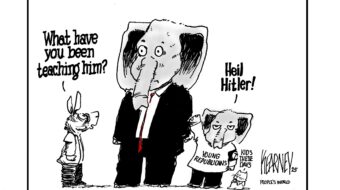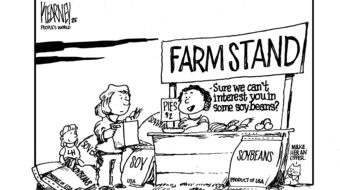
WASHINGTON – The House’s ruling Republicans, responding to right wing and tea party pressure, are seeking large cuts in domestic programs for the rest of this fiscal year – including 21percent from the Labor Department – and they promise more to come next year.
In their proposed “continuing resolution” to fund the government from March 4 through the end of fiscal 2011, on Sept. 30, the GOP wants to cut $2.9 billion of the DOL’s discretionary programs – job training, the Occupational Safety and Health Administration, etc. – from the $13.9 billion Democratic President Barack Obama originally sought for those 12 months.
Almost half of the GOP’s proposed cut, $1.4 billion, would be in grants to states for training and employment services, compared to how much the feds planned to send to states to help jobless workers find new positions, at a time of 9 percent unemployment.
The GOP-run House is expected to pass the continuing resolution during the week of Feb.14, with its cuts. Individual lawmakers may try to trim even more from spending, while many Democrats plan to defend programs aiding the jobless.
“It is my intent – and that of my committee – that this legislation will be the first of many appropriations bills this year that will significantly reduce federal spending,” said House Appropriations Committee Chairman Hal Rogers, R-Ky., whose panel helps make actual spending decisions.
But the House GOP’s plan is expected to run into resistance in the Democratic-run Senate, setting up a political confrontation in early March just as the government’s authority to spend money expires.
And the spending cut bill that lawmakers vote on this week is different from the budget plans for fiscal 2012, launched last week by the GOP and on Feb. 14 by Obama.
DOL declined to comment, despite repeated requests launched several weeks ago and renewed last week, about what such GOP cuts would mean in practical terms.
Rep. Norman Dicks, D-Wash., the top Democrat on the House Appropriations Committee – whose GOP majority unveiled the cut plan – said “additional sharp reductions in transportation, education, law enforcement and other areas of the budget” including job training “will only exacerbate the damage to our economy.”
The GOP defended its cuts as a way to reach the goal, uttered on last year’s campaign trail and responding to tea party anger, of reducing federal domestic spending by $100 billion this fiscal year. Besides the cut in job training grants to states, other proposed GOP cuts in DOL – all part of the overall cut – would include:
Another $165 million, so far unspent by the states, in grants to help dislocated workers – those who have lost their jobs due to unfair trade – retrain themselves or find new employment.
A $99 million cut in OSHA money, which is just under a fifth of its budget. Almost half of the cut (42 percent) would be in federal OSHA enforcement, while another 35 percent of the cut would be in money to gather safety and health statistics.
Yanking back any unspent stimulus law money nets a total of $2 billion government-wide. DOL was scheduled to get $565 million in stimulus law money in fiscal 2011. It could not be determined how much it has already received, or spent.
“The continuing resolution cuts excess spending in Labor Department job training programs,” the Republicans explained. “These programs have significant carryover balances from prior year appropriations and have already received $1.5 billion in advance funding available for the current fiscal year.”
- All $600 million in critical national infrastructure grants and all $1 billion for building high-speed rail lines. Both would employ thousands of construction workers at a time of 22.5 percent construction unemployment.
- $456 million to modernize the nation’s 50-year-old radar-based air traffic control system, a key cause of the National Air Traffic Controllers Association.
- $53.7 million from the National Labor Relations Board. That’s a 17 percent cut, and an agency spokeswoman said, if enacted, it could produce two months of furloughs.
- $17.5 billion – more than half – of money for Pell Grants. Low- and moderate-income college students, both recent high school grads and workers returning to learn new skills, use them to pay for college.
- Funds for signs that say the stimulus law is funding specific programs and projects.
Republicans contend the stimulus law failed because joblessness is still at 9 percent. Obama, Democrats, organized labor and outside economists say that without the stimulus law’s spending, the Great Recession would have turned into a second Great Depression, with official jobless rates at almost double present levels.
Image: Doug Geisler // CC BY-NC 2.0










